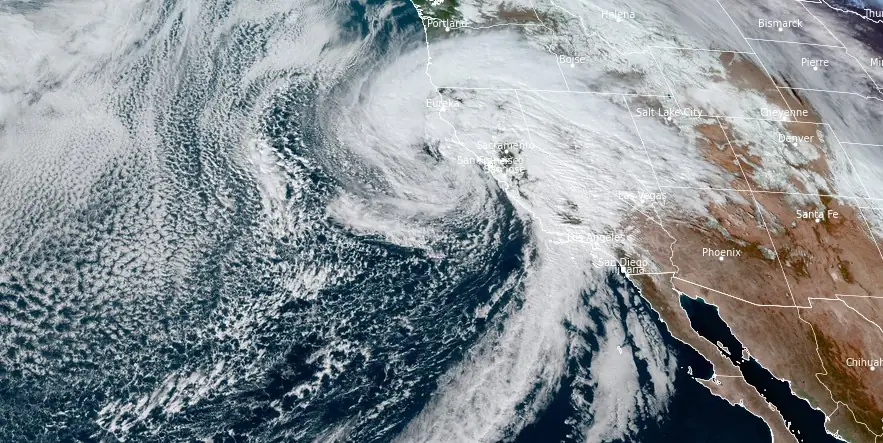Powerful atmospheric river triggers state of emergency in Southern California, rare Level 4 of 4 risk of excessive rainfall

An intense atmospheric river event hit California on Sunday, February 4, 2024, prompting Gov. Gavin Newsom to declare a state of emergency in eight counties due to the potential for “life-threatening” flooding, mudslides, and widespread power outages. The National Weather Service warns of significant rainfall, powerful winds, and heavy snowfall continuing over the next few days.
An intense, slow-moving atmospheric river that arrived in California on Sunday, February 4, 2024, has unleashed a series of severe weather phenomena across the state, including “life-threatening” flooding, mudslides, and widespread power outages.
This event has prompted Governor Gavin Newsom to declare a state of emergency in Los Angeles, Orange, Riverside, San Bernardino, San Diego, San Luis Obispo, Santa Barbara, and Ventura counties.
The National Weather Service (NWS) in Oxnard has highlighted the situation as one of the most dramatic weather days in recent memory, with a rare Level 4 of 4 risk of excessive rainfall announced for parts of Southern California, including Los Angeles, Santa Barbara, and Oxnard. This warning predicts rainfall rates of up to 25 mm (1 inch) per hour, resulting in total rainfall amounts of 76 to 152 mm (3 to 6 inches) across the affected areas.
The situation has led to significant disruptions, including the closure of Santa Barbara Airport due to flooding and the rescue of 19 people off Long Beach after their boat’s mast broke in high winds.
In Northern California, fallen trees and power lines have caused injuries and power outages, with over 800 000 customers currently without electricity.
The weather conditions have also impacted travel, with the NWS issuing its first-ever hurricane-force wind warning for San Francisco, forecasting winds of 64 to 97 km/h (40 to 60 mph) with gusts up to 153 km/h (95 mph) in the foothills and mountains. This has made travel in the mountains, particularly above elevations of 1 500 to 1 800 meters (5 000 to 6 000 feet), near impossible due to heavy snowfall and whiteout conditions.
School closures, flight delays, and the cancellation of sporting events, including NASCAR and PGA events, were reported.
Looking ahead, the NWS anticipates continued heavy rain, strong winds, and significant snowfall across much of central and southern California, with ongoing risks of flash flooding and landslides. The atmospheric river is expected to sag southward, concentrating heavy to excessive rainfall over southern California and the southern Sierra Nevada from Monday night into Tuesday, with potential areal totals of 25 to 76 mm (1 to 3 inches) of rain, and isolated higher amounts in Los Angeles and Orange Counties.
Updates
17:04 UTC, February 5
On Sunday, February 4, Los Angeles recorded 104 mm (4.10 inches) of rain, shattering the previous daily record for the date set in 1927 at 65 mm (2.55 inches) and surpassing the average February rainfall of 92 mm (3.64 inches).
The National Weather Service office in Los Angeles identified the day as the third-wettest February day since 1877 and the 10th wettest day on record, matching March 15, 2003.
The record for the wettest day in Los Angeles still stands from March 2, 1938, with 149 mm (5.88 inches) of rain. This event marked the wettest day Los Angeles has seen since December 28, 2004, nearly two decades ago.
Tragically, the severe weather resulted in the death of a man in Yuba City, near Sacramento, who was killed by a falling tree while reportedly attempting to clear it from his home using a ladder. Despite emergency responders’ efforts to save him, the man was found under the large redwood tree and pronounced dead at the scene.
12:04 UTC, February 6
The California Governor has declared a state of emergency in eight counties due to severe weather impacts, with Los Angeles, Monterrey, Santa Barbara, Ventura, San Diego, Santa Clara, San Mateo, Santa Cruz, Sutter, and Sacramento being the worst affected.
According to a FEMA report dated February 5, there have been three fatalities across Sacramento, Santa Cruz, and Sutter Counties. The report also highlights that 77 individuals have been evacuated to five shelters, with 3,160 people receiving mandatory evacuation orders and numerous roads closed in the affected areas. Additionally, 17 schools in San Diego County have suffered damage.
The forecast predicts further heavy rainfall and thunderstorms over southern and central California in the next 24 hours, with NOAA issuing several flood advisories for the region.
References:
1 Short Range Forecast Discussion NWS Weather Prediction Center College Park MD 251 PM EST Sun Feb 04 2024
2 Emergency declaration and urgent warnings as Southern California storm gains ferocity – Los Angeles Times – February 4, 2024
Featured image credit: NOAA/GOES-West, RAMMB/CIRA, The Watchers. Acquired at 22:40 UTC on February 4, 2024






All rivers have river banks. Where are the river banks, if it is an “atmospheric river?”